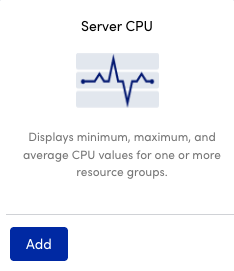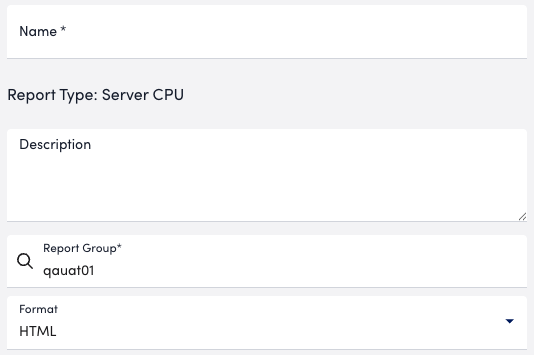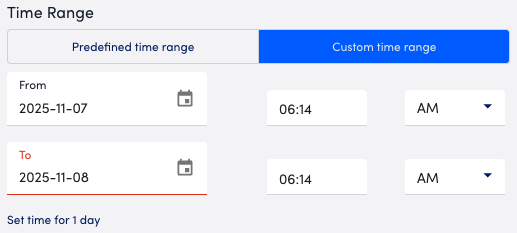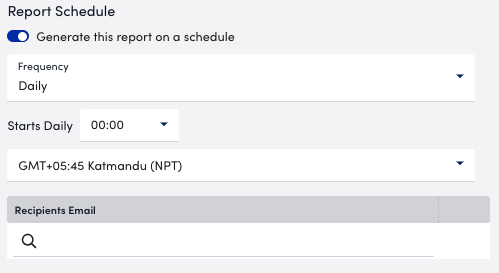Server CPU Report
Last updated - 09 December, 2025
The Server CPU report displays minimum, maximum, and average CPU values across multiple resources of different types and with different CPU DataSources. The information is displayed as a table with the option to include graphs for each resource. You can use this report to review recent CPU performance across a group of resources. Because the flexibility of this report allows you to view graphs and numerical data together across multiple resource types, you may find this report useful for reviewing recent CPU performance across a group of resources.
Configuring a Server CPU Report
- In LogicMonitor, navigate to Reports.
- Select
 Add Report, select Add for the Server CPU report.
Add Report, select Add for the Server CPU report.
- In the Name field, enter a name for the report.
Report names cannot include the operators and comparison functions used in the LogicMonitor datapoint expression syntax. - (Optional) In the Description field, enter a description for the report.
For example, you can enter a description of the specific purpose of the report. - From Report Group, select the report group where your report is stored.
Matching groups display as you type, and you can select the group from the list. - From Format, select the type of format (for example, HTML, PDF, or CSV) for the output of the report.

- In Time Range settings, configure the time range you want to base the report on by doing one of the following:
- To configure a predefined time range, select Predefined time range, and then select on of the time range options.

- To configure a custom time range, select Custom time range, and then configure the date and time.

- To configure a predefined time range, select Predefined time range, and then select on of the time range options.
- In the Resource Groups/Resources section, add resources to the report by doing the following:
- From Choose Type, select either “Resource” or “Resource Group”.
- In the Resource Group/Resources field, enter the name of a resource or resource group.
The report is restricted to the data entered in these fields.
You can use explicit names or glob expressions in these fields.
Note: You can select a combination of both glob and distinct values to specify your resources and resource groups. For more information, see Using Glob in your LogicMonitor Portal.
- To limit the number of results displayed in the report, toggle the Top 10 only switch.
Graphs are only displayed if this option is selected. - To display all relevant graphs of CPU values, toggle the Show graphs at end of report switch.
If enabled, graphs are appended to the end of the report, after the table of CPU values. - In Report Schedule settings, do the following to configure the report to generate on a schedule:
- Toggle the Generate this report on a schedule switch.
- From the Frequency dropdown menu, select how frequent you want the report to generate, and then configure when you want the report to generate.
For example, if you configure the report to generate daily, you can choose the time to generate the report each day. If you configure the report to generate weekly, you can choose the day of the week and time to generate the report for the selected date. If you configure the report to generate monthly, you can configure the day of the month and time to generate the report.
Each frequency option provides you a setting for selecting the time zone. - In Recipients Email, enter the name of the user you want to receive the generated report. You can also add recipient groups.
You can enter as many users as needed.
LogicMonitor attempts to match values as you type.
The recipients you add to the report are emailed a generated report based on the format you configured and the email associated with the username.
Note: When configuring a delivery schedule, your report is generated and emailed immediately if it has not been generated within the last 24 hours. After that, emailed delivery only occurs according to the schedule.
- To save the report, do one of the following:
- Select Save.
The report saves to the Report Group you selected.
If you configured the report to generate on a schedule, the report generates and sends to recipients based on the frequency you configured. - Select Save and Run.
The report saves to the Report Group you selected and generates a report based on the format you configured.
If you configured the report to generate on a schedule, the report generates and sends to recipients based on the frequency you configured.
- Select Save.
Threshold Limits
Note: For ad-hoc reports, you must select the maximum date range as less than or equal to last month. If you require a date range more than the previous month, you must schedule the required reports.
Adhoc Requests Thresholds (Limit for number of graphs)
| CSV | HTML | |
| 20 | 20 |
Scheduled Requests Thresholds (Limit for number of instances)
| CSV | HTML | |
| 600 | 600 |
Adhoc Requests Thresholds (Limit for number of instances)
| CSV | HTML | |
| 500 | 500 | 500 |
Scheduled Requests Thresholds (Limit for number of instances)
| CSV | HTML | |
| 32800 | 5000 | 5000 |


